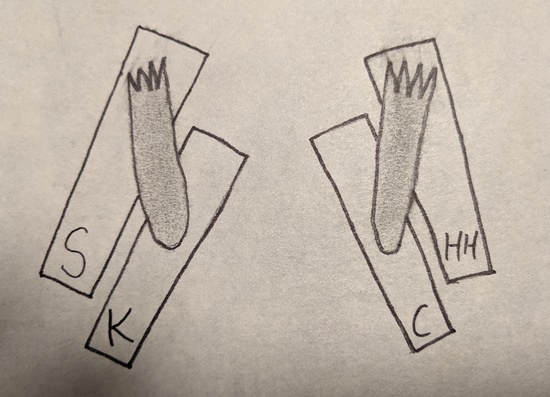Now that I've been playing heel-toe for a couple months I have some idea about how to do it. I wanted to write something up in case other people are interested in learning. Since each foot can play two pedals, a basic set up is four beaterless pedals:
I'm using the Yamaha KU-100 pedal, left to right as:
- Left toe: snare
- Left heel: kick
- Right heel: cymbal
- Right toe: hi-hat
Here's what I have them set to sound like, with my DTX-500:
In teaching myself to play, I've worked on figuring out specific patterns. Each is a nice concrete step, and once I get a pattern into my muscle memory I can play it without conscious effort. As I've learned more, I've felt my fluency increase, where progressively more complex patterns will just come out, fitting whatever I happen to be playing on the piano. Often I will get to a place where there's something that feels like it should go with the music is too hard, so I'll stop and work it out, and repeat it until it's solid.
Here are a set of patterns that you might find a useful starting place if you are teaching yourself:
1. Kick on the downbeat
Tap your left heel in time with the music. Work on getting it completely steady.
2. Kick on the downbeat, hi-hat on the upbeat
Continue tapping your left heel on the downbeat, but now add your right toe on the upbeat.
3. Kick on 1 + 3, snare on 2 + 4
On successive downbeats, alternate between tapping your left heel and left toe.
4. Combine both
This is the two previous ones together: kick on 1 + 3, snare on 2 + 4, and high hat on every upbeat.
5. Add cymbal
Go back to kick and snare, but add the cymbal on the upbeat at the very end of the phrase.
6. Kick on 1 + 2&, snare on 2 + 4
This is the same as kick and snare on successive downbeats, but the second kick is slightly earlier, on the upbeat.
7. Add hi-hat
Now add the hi-hat on the upbeat.
8. Make things up and keep exploring!
Listen to patterns in music you like, listen to what the music you're playing seems to be saying should come next, focus on learning things just on the edge of what you can do.Comment via: facebook
